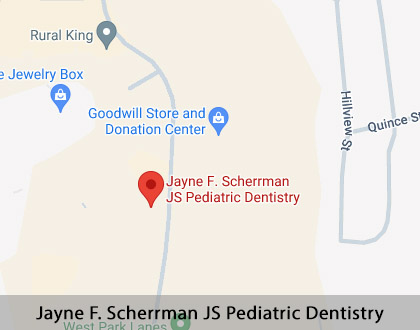What Is a Frenectomy Cape Girardeau, MO
Many children struggle with an oral condition known as "tongue-tie." If your child has a tongue-tie, the dentist might recommend a minor surgery. Learning that your child needs surgery can be scary and confusing. But many childhood dental procedures are fast and low-risk. A frenectomy can repair tongue-tie during a single office visit.
Pediatric dentists are available at Jayne F. Scherrman JS Pediatric Dentistry in Cape Girardeau and the surrounding area. Our team helps parents plan their child's procedure. We offer compassionate care for children and ongoing support for parents. Call us at (573) 271-3062 to learn more about our services.
Understanding the Primary Frena
The frena are delicate strips of connective tissue. They connect loose parts of the mouth, like the tongue, to the jaw or gums. Oral frena can be broken down into three categories:
- The lingual frenum: connects the tongue to the lower jaw.
- The labial frenum: connects the lips to the front teeth.
- The buccal frena: connects the gums and the inside of the cheeks.
Children can develop problems with any of these oral tissues. Challenges with the lingual frenum are especially common. Sometimes, the tissue is very short at birth. A shortened lingual frenum prevents the tongue from moving freely. Doctors and dentists call this condition "tongue-tie."
Tongue-tie can make it hard for a baby to breastfeed. Children with tongue ties might also develop speech issues as they grow older. If a child has an abnormal labial and buccal frena, they might develop orthodontic problems. Their teeth might not shift into the correct position.
Fortunately, an outpatient procedure called a frenectomy can help. A frenectomy adjusts the size and shape of the frena. It can help babies breastfeed more easily. The procedure also reduces the risk of future oral health problems.
“A shortened lingual frenum prevents the tongue from moving freely.”
When to Consider a Frenectomy
Doctors can often diagnose a tongue-tie early on. Many cases of tongue-tie are detected in this hospital just hours after birth. But sometimes, the condition goes unnoticed. Problems may not arise until the child reaches school age. Your child's teacher might spot some speaking or pronunciation issues. The teacher might suggest a medical and dental evaluation.
During routine dental care, the dentist looks for problems with the frena. If they notice any abnormalities, they determine whether further care is needed. Not every child with abnormal frena needs surgery. Some issues may resolve on their own. But if surgery is necessary, the dentist can explain the next steps.
“During routine dental care, the dentist looks for problems with the frena.”
What to Expect During a Frenectomy
Most frenectomies are outpatient procedures. In older children, the procedure might take as little as 15 minutes. To begin, the doctor determines what kind of procedure to perform. They may opt for a traditional or a laser frenectomy.
During a traditional frenectomy, the dentist numbs the child's mouth. Next, they use a sharp instrument to sever the tissue. This process might sound frightening, but it is a routine procedure that can be performed within seconds. After the dentist snips the tissue, they might cauterize it. In some cases, the dentist closes the area with stitches. These stitches often dissolve on their own within a few weeks.
Laser frenectomies do not require scalpels or incisions. They can sometimes be performed without an anesthetic. Laser frenectomies offer added precision and control for the dental provider. Patients often experience less bleeding, too.
“In older children, the procedure might take as little as 15 minutes.”
Check out what others are saying about our dental services on Yelp: What Is a Frenectomy in Cape Girardeau, MO
Preparing Your Child for the Procedure
During the consultation, parents can speak to the provider about their child's procedure. Each procedure looks a little different. The provider accounts for the child's age, activity level, and tolerance for discomfort.
Some patients might receive a light sedative or other medications. These drugs help the child stay calm and relaxed during the procedure. Parents typically remain with their children throughout the procedure. They can provide additional comfort and reassurance.
If the child is older, parents should talk with them about their upcoming procedure. Use simple, positive language. Explain that the provider wants to help their mouth grow well. Parents and caregivers can reassure the child that the procedure will not hurt and that they will stay with them.
Frenectomies in Infants
In babies, the procedure is especially quick. An infant's frenum is thin and has very few nerves. As a result, an anesthetic is not needed. There is little to no bleeding. Doctors and dentists can usually complete the procedure within 60 seconds. The baby can breastfeed immediately after the procedure.
“Some patients might receive a light sedative or other medications.”
Questions Answered on This Page
Q. What are some symptoms of tongue-tie?
Q. What happens during a frenectomy?
Q. How can I prepare my child for a frenectomy?
Q. How do I take care of my child after a frenectomy?
People Also Ask
Q. What services are offered by a pediatric dental provider?
Aftercare
Keep the incision area clean, and avoid any sharp foods for a few days. The dentist can provide a list of recommended foods for the recovery period. The child might also receive antibiotics to prevent infection. Make sure the child takes the medication as directed. Most patients can resume their normal activities within a day. In older children, full recovery may take up to two weeks. Babies usually recover much faster.
“Most patients can resume their normal activities within a day.”
Frequently Asked Questions
Q. What is a frenectomy?
A. During a frenectomy, the provider severs the connective tissues inside your child's mouth. This procedure can improve speech and tooth alignment. If your child is an infant, a frenectomy might make it easier for them to breastfeed.
Q. Does my child need a frenectomy?
A. If the connective tissue is shorter than usual, your child might need a frenectomy. But not all children need this procedure. Sometimes, the problem resolves on its own. In other cases, the problem is not severe enough to warrant treatment. Jayne F. Scherrman JS Pediatric Dentistry can explain your child's prognosis and unique needs.
Q. Do frenectomies hurt?
A. The connective tissues severed during a frenectomy usually have few nerve endings. In some cases, the provider may use a local anesthetic to numb the area. But often, the procedure causes no pain, even without anesthesia.
Q. What medication will my child receive?
A. Some children may not need any medication. The frenum is very thin and contains few nerve endings. Skilled providers can often perform the procedure without numbing medicine. However, if medication is needed, a pediatric dentist can use a local anesthetic.
Q. How long will it take to recover?
A. Infants who receive a frenectomy will usually need little to no recovery time. They can breastfeed right after their procedure. Older children might need to change their diet for a day or two following the procedure. But most children can return to school right away.
Quality Pediatric Dental Services Can Transform Smiles
By visiting us as soon as possible, our team can help get your child the professional treatment they need.
Definition of Pediatric Dental Terminology
Call Us Today
A frenectomy might sound frightening, but this procedure takes just a few moments to perform. The procedure causes little pain and blood loss. Some children may not feel it, and recovery time is usually swift. A frenectomy can resolve even stubborn problems with sucking or speech.
If you are looking for a new pediatric dental provider, let Jayne F. Scherrman JS Pediatric Dentistry in the Cape Girardeau help. Call us at 573-271-3062 to learn more about our services and policies.
If you live in the Cape Girardeau area, call 573-271-3062 for an appointment in our Cape Girardeau office.
Helpful Related Links
- American Dental Association (ADA). Glossary of Dental Terms. 2024
About our business, license, and website security
- Jayne F. Scherrman JS Pediatric Dentistry was established in 1978.
- We accept the following payment methods: Cash, Check, MasterCard, and Visa
- We serve patients from the following counties: Cape Girardeau County
- We serve patients from the following cities: Cape Girardeau, Jackson, St. Genevieve, Perryville, Poplar Bluff, Sikeston and Southeast Missouri
- MO (License #15413). View License Information and Specifics
- National Provider Identifier Database (1790848547). View NPI Registry Information
- Healthgrades. View Background Information and Reviews
- Norton Safe Web. View Details
- Trend Micro Site Safety Center. View Details
Back to top of What Is a Frenectomy







